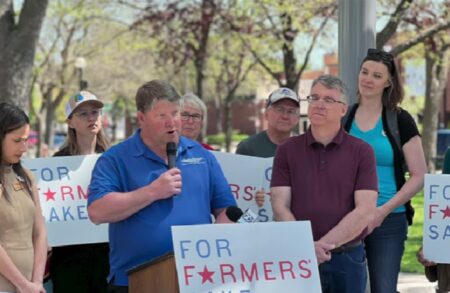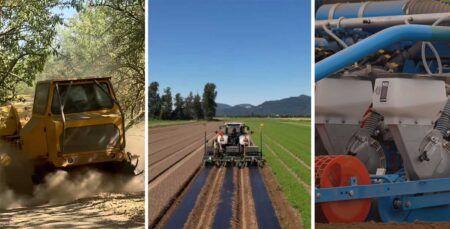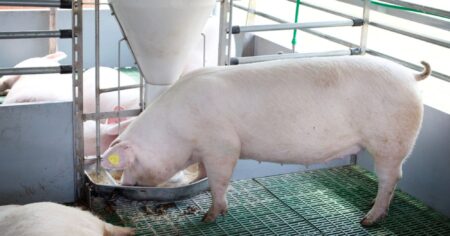By Scott Irwin and Todd Hubbs
The U.S. Environmental Protection Agency (EPA) has been extraordinarily active on the Renewable Fuel Standard (RFS) front over the summer and early fall of 2025. Since June, the agency has released three pivotal decisions that collectively are likely to alter the trajectory of the biomass-based diesel industry in the U.S. The vast majority of biomass-based diesel produced in the U.S. is made up of FAME biodiesel and renewable diesel (farmdoc daily, Feb. 8, 2023). The timing and magnitude of these policy shifts represent one of the most significant regulatory developments for the RFS program in the last decade.
The three key EPA actions in recent months are: i) proposed renewable volume obligations (RVOs) for 2026 and 2027 released in June 2025; ii) a comprehensive rulemaking on small refinery exemptions over 2018-2024 that was released in July 2025; and iii) a reallocation policy framework for small refinery exemptions published in September 2025. When examined individually, each decision represents a meaningful policy development. However, when analyzed collectively through the lens of biomass-based diesel RVOs, their combined impact appears to create conditions for a dramatic increase in domestic biomass-based diesel production. The purpose of this article is to analyze the combined implications of recent EPA actions for biomass-based diesel RVOs over 2023 through 2027. The article builds upon the analysis of the renewable diesel boom found in a series of previous farmdoc daily articles.
Analysis
To understand the significance of EPA’s recent actions, it is essential to first review the RFS policy environment that existed through the first half of 2025. The renewable diesel boom that began in earnest during 2021 fundamentally transformed the biomass-based diesel market, creating supply conditions that posed new challenges for RFS administration (farmdoc daily, March 29, 2023). By mid-2023, renewable diesel production capacity had expanded to levels that, combined with traditional FAME biodiesel production, were approaching the upper bound of what existing RVOs could accommodate without triggering what we previously termed a “RIN cliff” scenario (farmdoc daily, May 31, 2023). When biomass-based diesel production exceeds the RVO, D4 RIN prices plunge due to the oversupply, which in turn causes biomass-based diesel prices and production profits to drop precipitously. This is the situation that largely prevailed through the first half of 2025.
The small refinery exemption (SRE) program had been a persistent source of uncertainty regarding implementation of the RFS since its inception (farmdoc daily, Dec. 6, 2017). The program allows small refineries to petition the EPA for exemptions from RFS obligations if they can demonstrate disproportionate economic hardship. However, the granting of SREs has been the subject of a long series of court challenges (farmdoc daily, March 12, 2020). The result was a large backlog of SRE petitions going into 2025, with nearly 200 pending applications spanning multiple compliance years. This backlog created significant uncertainty about the effective level of biomass-based diesel demand, as exempted gallons have the potential to reduce the total volume of biofuels that obligated parties must blend or purchase RINs to cover.
Whether SREs reduce biomass-based diesel demand depends on “reallocation.” Specifically, when EPA grants exemptions, it must decide whether to reallocate exempted volumes to other obligated parties or to effectively reduce the total RFS obligation. Under the first Trump Administration, the EPA did not reallocate SREs until the 2020 compliance year and this had a devastating impact on the biomass-based diesel industry (farmdoc daily, July 12, 2018; Feb. 12, 2025). The question of reallocation created substantial uncertainty about the effective demand for biomass-based diesel in 2026 and 2027 even after the proposed RVOs and volumes of SREs were known. The September 2025 reallocation document provided a range of reallocation options. Which one the EPA ultimately adopts will have implications for market demand and, consequently, for RIN pricing dynamics.
With this background, we begin our analysis with a review of EPA’s June 2025 proposal for 2026 and 2027 RVOs. Panel A of Table 1 presents the RVOs for these two years based on the June proposal. In addition, the final RVOs for 2023-2025 are included to provide a baseline for evaluation of subsequent policy changes. The proposed RVOs for 2026 and 2027 represented a continuation of the EPA’s approach of setting obligations that generally align with projected biofuel production capacity. For biomass-based diesel specifically, the proposed RVOs reflected the agency’s assessment of the continued expansion of renewable diesel production capacity while maintaining obligations that would keep the D4 mandate economically binding. The net result was a robust increase in the biomass-based diesel RVO from 5.36 billion gallons in 2025 to 7.50 billion gallons in 2027, a 40% increase. The advanced and total RVOs increased in parallel. The conventional RVO remained at 15 billion gallons, where it had been set for several years.
farmdoc
Panel B of Table 1 shows the percentage RVOs, which are computed as the volume RVOs in Panel A divided by total obligated gasoline and diesel production (including imports) for the 48 lower-continental states plus Hawaii. Compliance with annual RFS mandates is based on the percentage RVOs rather than absolute volumes (farmdoc daily, Feb. 23, 2018). Obligated parties — petroleum refiners and importers — use the percentages to calculate firm-specific RVOs by multiplying the applicable percentage standard by their fuel production and/or imports. Crucially, the projection of obligated petroleum gasoline and diesel for 2026 and 2027 was based on relatively low EIA forecasts made in 2023. This had the effect of pushing up the percentage RVOs for 2026 and 2027 even more than what would have been expected based on the increases in the gallon RVOs shown in Panel A.
The June proposal from the EPA did not resolve the small refinery exemption backlog or the establishment of a clear reallocation policy. As a result, the RVOs presented in Table 1 for 2023 through 2027 represented only a partial picture of the ultimate RFS obligations that would emerge following the EPA’s subsequent policy actions.
In what was likely the most surprising part of the June rulemaking, the EPA proposed lowering the RIN value by 50% for biofuel produced domestically with foreign feedstock or imported biofuel. The so called “half RIN” dramatically changes the status of imported products under the RFS. Additionally, the EPA proposed lowering the D4 RIN equivalence value for non-ester renewable diesel from 1.7 to 1.6 RIN’s per gallon. The vast majority of renewable diesel and SAF are derived from the HEFA process. This change of policy places FAME biodiesel, which receives 1.5 RIN’s per physical gallon produced, on a more equal basis with renewable diesel. These proposals have major implications for the type of biomass-based diesel produced to meet the expanded RVO’s and the sourcing of feedstocks to meet the mandate.
The EPA’s July 2025 release of comprehensive decisions on small refinery exemptions for 2016-2024 represents one of the most significant developments in the history of the exemption program. The agency acted on a backlog of 175 SRE petitions from 38 small refineries covering the 2016-2024 compliance years. The scale of this action and its implications for RFS market dynamics cannot be overstated.
The decision document revealed that the EPA took a considerably more restrictive approach to granting exemptions compared to the first Trump Administration. The agency’s analysis focused on refineries’ financial conditions and their ability to comply with RFS obligations without experiencing disproportionate economic hardship. Out of the total 175 SRE petitions, 7 were deemed ineligible, 28 were denied, 77 were provided with 50% exemptions, and only 63 were granted full exemptions. In addition, if SREs were granted for 2018-2022, after compliance had formally closed for those years, the EPA returned the original RINs rather than “replacement” RINs with the vintage year updated to the current compliance year as requested by the petitioning refiners. Since the original RINs had expired, and were therefore worthless, the petitioning refineries did not receive any compensation for the 2018-2022 SREs that were granted. The scale of the potential increase in D4 RIN supply if replacement RINs had been awarded for these years, 3.96 billion gallons, is very large and would have substantially undercut the RVOs proposed earlier in June. The EPA stated in its rulemaking document that the “sheer volume” of the replacement RINs would have caused “large scale disruptions to the RIN market.” Given the economic stakes involved, this matter is likely to be the subject of continuing litigation.
The cumulative impact of the SRE decisions was to significantly reduce the volume of exemptions granted relative to industry expectations and to reduce the potential supply of D4 RINs. This outcome effectively increased the total RFS obligation by maintaining higher levels of compliance requirements across the refining sector.
The EPA’s September 2025 release of its reallocation policy framework completed the trilogy of major RFS decisions. Due to the backlog of SREs, reallocation decisions impacted RVOs for each year over 2023 through 2027. For 2023-2025, the EPA did not retroactively reallocate any SRE volumes. For 2026-2027, the EPA focused on two prospective scenarios: 100% and 50% reallocation. This suggests that the EPA has a clear preference moving forward for at least partially reallocating exempted volumes to other obligated parties rather than reducing the overall RFS obligation. This approach maximizes the total demand for biofuels by ensuring that exempted volumes are not fully lost to the system but rather redistributed among remaining obligated parties. The reallocation mechanism operates by calculating the total volume of exemptions granted and then proportionally increasing the obligations of non-exempted refineries and importers. This approach ensures that the statutory mandate volumes are maintained while accounting for the reduced volume of obligations due to exemptions.
With this information in hand, we can estimate the impact of the SRE and reallocation decisions on the 2023-2027 RVOs. Panel A of Table 2 shows that the RVOs for 2023 are lower by the amount of SREs awarded for that year. Similar adjustments are made for 2024 and 2025. In addition, the revised RVOs incorporate updated projections of obligated petroleum gasoline and diesel volumes for 2026 and 2027 that were released at the same time as the September 2025 reallocation framework. The new projections are based on updated 2025 EIA forecasts of gasoline and diesel consumption in the U.S. as well as revised adjustment factors for the difference between EIA and EPA volumes. Consequently, the estimate of obligated petroleum gasoline and diesel for 2026 increased from 167.9 billion gallons in the June proposed RVO rulemaking to 180.2 billion gallons. In a parallel fashion, the projection of obligated gasoline and diesel volume for 2027 jumped from 165.9 to 178.4 billion gallons.
farmdoc
The differences between Tables 1 and 2 reveal the magnitude of the impact on RVOs from the SRE and reallocation policy changes. To begin with, note that percentage RVOs for 2023-2025 are unaffected by the changes, but the gallon RVOs are impacted due to the SRE actions and higher (implied) projections of obligated gasoline and diesel use. The net result is that changes to the gallon RVOs over 2023-2025 are relatively modest, with the largest change a 590 million gallon increase in the total RVO for 2025. Naturally, the impact of the changes is larger for 2026 and 2027 because both the gallon and percentage RVOs change. It is interesting to note that the percentage RVOs for 2026 and 2027 decrease under both the 100% and 50% reallocation scenarios, but the gallon RVOs increase. This seemingly contradictory pattern is due to the large increase in projected gasoline and diesel usage for 2026 and 2027 decreasing percentage RVOs even after considering reallocation, demonstrating the important impact of the EPAs new methodology for projected petroleum gasoline and diesel volumes.
The net result is that the revised RVOs shown in Panel A of Table 2 are moderately higher under both 100% and 50% reallocation in 2026 and 2027 compared to the baseline June proposal in Table 1. For 2026, the revised biomass-based diesel RVO represents an increase of 220 million gallons under 100% reallocation and 110 million under 50% reallocation compared to the June proposal. For 2027, the increase is even larger at 270 million gallons under 100% reallocation and 140 million gallons under. It is interesting to note that increases in conventional RVOs are even larger, ranging from 360 to 780 million gallons. This is a logical consequence of reallocation having the biggest impact on the largest of the RVOs, which is the conventional category.
The bottom-line is that the revised RVOs for biomass-based diesel are now somewhat larger than first proposed under the June preliminary rulemaking by EPA. Figure 1 provides a useful perspective on the magnitude of the revised RVOs. On average, the revised biomass-based diesel RVOs average 4.98 billion gallons over 2023-2025. This compares to an average of 7.50 billion gallons across the two reallocation scenarios for 2026 and 2027, which represents slightly more than a 50% increase in volume. Such a significant increase in RVOs over a relatively short period of time will inevitably have substantial impacts on biomass-based diesel and related feedstock markets.
farmdoc
Lastly, it is important to emphasize that the RVOs presented in Table 2 have not been finalized, but, rather, are projections based on the June preliminary rulemaking, the July SRE decisions, and the September reallocation framework. The assumptions we used to project the revised RVOs may be different than what the EPA uses when developing the final RVOs for 2026 and 2027. But, if history is any guide, the EPA will not depart substantially from the assumptions embedded in our projections.
Implications
The EPA’s trilogy of recent RFS decisions represents one of the most significant regulatory developments for biomass-based diesel in the program’s history. The combined effect of higher RVOs, more restrictive small refinery exemptions, and mandatory reallocation creates substantially higher biomass-based diesel requirements for 2026 and 2027. Compared to 2023-2025, revised biomass-based diesel RVOs look to increase around 50% over 2026-2027. A policy shift of this magnitude should support higher D4 RIN prices and improved profitability for biomass-based diesel producers. The feedstock implications are especially significant, as meeting the expanded mandates will require large volumes of soybean oil and other feedstocks, with potentially important consequences for vegetable oil prices, soybean crush margins, and crop acreage decisions. In sum, the RFS policy landscape for 2026-2027 is now considerably clearer, and it points toward substantially higher demand for biomass-based diesel than most market participants anticipated just six months ago. We will examine the implications of the policy changes for biomass-based diesel and feedstock markets in more detail in an upcoming article.
Rewriting the RFS Playbook: The Impact of Recent EPA Decisions on 2023-2027 RVOs for Biomass-Based Diesel was originally published by Farmdoc.












